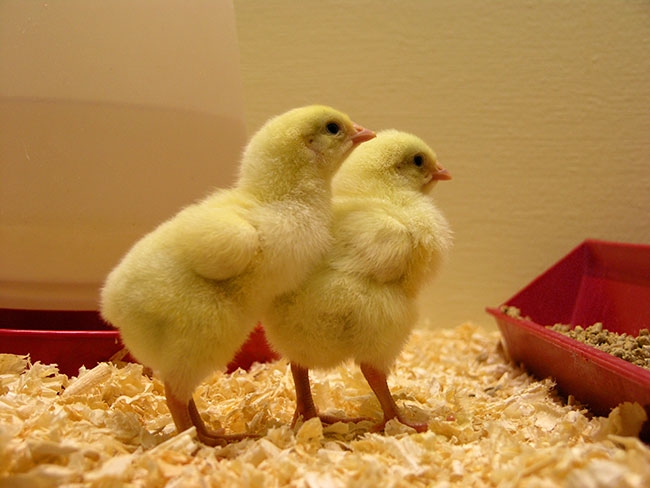
Management is key to antibiotic-free production
By Melanie Epp
Features Bird Management Production Diseases Global Poultry Production SustainabilityFive elements to focus on for better results in antibiotic-free birds.
 When it comes to feeding, there’s no “one-size fits all” answer for producing antibiotic-free birds.
When it comes to feeding, there’s no “one-size fits all” answer for producing antibiotic-free birds. In November 2016, poultry producers from around the world gathered to hear Erik Helmink, marketing director at HatchTech, share his expertise on antibiotic-free poultry production at EuroTier, the world’s largest livestock production trade fair.
Antibiotic-free (ABF) production is a hot topic right now – one with which many producers are grappling. And so they hunkered down, expecting a long and complicated talk full of specific instructions and stacks of statistics. To their surprise, though, Helmink didn’t unveil the silver bullet. Instead, he highlighted what most producers already know: the basics – temperature, light, stress, nutrition and water.
TEMPERATURE
Uniform temperature, Helmink said, is key to embryo production. To ensure every egg is treated exactly the same way, HatchTech uses a unique airflow system, MicroClimer, and laminar airflow technology. According to Helmink, every embryo in the incubator is kept at the optimal temperature, which makes for outstanding development. In big machines where there are 100,000 eggs in one unit, he said each egg has to be handled individually to ensure the embryo develops in a proper way.
“The better the embryo develops, the better the chicken is after them,” he said.
LIGHT
Light is an important issue in the development of a chicken. In their extensive research, poultry experts at HatchTech found light is an important factor in healthy bone development. Light also helps the young chicks find food and water, which is absolutely necessary for strong development early on.
STRESS
Stress is a risk for development of sub-clinical disease, so ensuring the birds are raised in a stress-free environment is a key factor in raising ABF poultry. One way of minimizing stress is ensuring access to food and water at all times. It takes a chick about 25 hours to hatch, Helmink said. After it has hatched, it’s time for recovery. First comes the cleaning of the feathers, then it’s time to find food and water.
“We separate the chick in the basket – calm and relaxed – where it can dry up,” Helmink explained. “The provision of this stress-free environment helps with the development of the animal.”
“We see that the availability of water and feed reduces stress for the animals, and we also see that the birds stay in the place where they were born, thereby reducing travelling throughout the hatchery.”
WATER
In the 24 hours following hatching, a broiler will lose about six per cent of its body weight, even when conditions are perfect, Helmink explained. But getting and keeping birds hydrated is difficult, especially given the environment they’re born into. The hatchery is, after all, the perfect environment for hatching eggs.
“For chicks, it’s a compromise,” he said. “At the moment they are able to give the bird water – at the moment that they come out of the egg – you see that we can find the dehydration problem.”
According to experts from Alltech Canada, not just any water will do, though. In a recent interview, Kayla Price said water pH is an important factor to consider, especially since good bacteria generally like a more acidic pH. Bad bacteria, like Clostridium perfringens, E. coli and Salmonella prefer a more basic pH. Price suggests a pH between 5.0 and 6.5 and recommends using an acidifier.
“The type of acidifier becomes very important too,” added her colleague, Ted Sefton, director of poultry at Alltech Canada. He suggests an acidifier based on organic acids. Organic acid is more stable than inorganic acid, which means it will make it to the hindgut where the bad bacteria generally live.
FEED
Unfortunately, there’s no silver bullet approach for producing ABF birds. Doing so requires a combination approach that includes all of the above, as well as good nutrition. Timing is also crucial. In his talk, Helmink noted the importance of feeding immediately post-hatch.
“Although the yolk sack acts as feed and is basically the raw material needed to build body tissue, we see at the moment that we give them feed, better development of the intestine [is enabled], and because of that development of the intestine, feed conversion improves,” Helmink explained. “We also see better development of the bursa, which is the immune organ, so we see the creation of more robust chickens.”
After ingesting food and water, the birds will weigh 12 to 15 per cent more than when they first emerged.
While timing is important, quality is also essential. Price and Sefton recommended using top quality ingredients, especially in the pre-starter and starter feed. It’s also important to make sure the feed is free from harmful contaminants and mycotoxins.
Often “raised without antibiotics” production goes hand-in-hand with animal by-product-free programs, which means birds are likely ingesting more complicated feed, like soy. If it’s not presented in the right way, protein can be difficult to digest, Price explained. She suggested adding enzymes to the more complicated feeds in order to help release nutrients.
Quality pre-starter and starter feed can be expensive, but Price and Sefton think they’re necessary in order to set the bird up for success. “You don’t want to ignore the grower and finisher period near the end,” Price said. “But make sure you put a strong importance on
that beginning.”
“In terms of cost, the pre-starter and starter diet may be your high-end cost in terms of the ingredients that you put into the diet, but it is only eaten for a short amount of time,” she added. “And it’s a relatively small amount because the birds are small. Putting this high investment in at the beginning can be a very important long-term investment throughout the entire life of the bird.”
Print this page